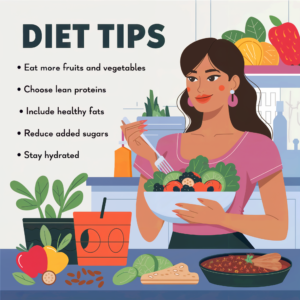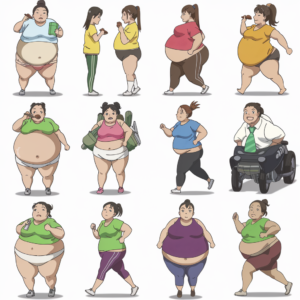How to Lose Weight with the Volumetrics Diet: A Step-by-Step Guide for Beginners
Introduction to the Volumetrics Diet
The Volumetrics Diet, developed by Dr. Barbara Rolls, is a science-based eating plan that focuses on the concept of energy density. The goal of the diet is to promote weight loss by encouraging the consumption of low-calorie, high-volume foods that help you feel full and satisfied without  consuming excessive calories. By prioritizing foods with high water and fiber content, such as fruits, vegetables, and soups, the Volumetrics Diet allows you to eat larger portions while keeping your calorie intake low. This makes it an effective and sustainable approach for those looking to lose weight without feeling deprived.
consuming excessive calories. By prioritizing foods with high water and fiber content, such as fruits, vegetables, and soups, the Volumetrics Diet allows you to eat larger portions while keeping your calorie intake low. This makes it an effective and sustainable approach for those looking to lose weight without feeling deprived.
The key principle of the Volumetrics Diet is to fill up on foods that are high in volume but low in calories. This approach helps create a calorie deficit while ensuring you’re eating enough to stay satisfied. In this guide, we’ll explore how the Volumetrics Diet works, its benefits, and tips for creating a successful Volumetrics diet meal plan for weight loss.
How the Volumetrics Diet Works for Weight Loss
The Volumetrics Diet works for weight loss by focusing on foods with a low energy density, meaning they provide fewer calories per gram of food. This allows you to eat larger portions of food while still consuming fewer calories overall, which helps create a calorie deficit necessary for weight loss. The diet emphasizes high-water, high-fiber foods like fruits, vegetables, and broth-based soups, which add volume to your meals without adding excessive calories.
The idea is that by eating foods that are lower in calories but higher in volume, you’ll feel fuller for longer, which reduces the likelihood of overeating or snacking on high-calorie foods. This makes it easier to stick to the diet and achieve sustainable weight loss.
Key Foods in the Volumetrics Diet
- Fruits and Vegetables: Fruits and vegetables are naturally low in calories and high in water and fiber, making them the cornerstone of the Volumetrics Diet. These foods provide bulk to your meals, helping you feel full without consuming too many calories.
- Soups and Stews: Broth-based soups and stews are encouraged on the Volumetrics Diet because they are low in calories and high in volume, thanks to their water content. Eating soup before a meal can help reduce overall calorie intake.
- Whole Grains: Whole grains like brown rice, quinoa, and oats are included in the diet because they provide fiber and slow-digesting carbohydrates that help keep you full.
- Lean Proteins: Lean proteins such as chicken, turkey, fish, and plant-based options like tofu and beans are important for maintaining muscle mass while promoting satiety.
- Low-Fat Dairy: Low-fat dairy products, such as yogurt, milk, and cheese, provide protein and calcium while being lower in calories than their full-fat counterparts.

Benefits of the Volumetrics Diet for Weight Loss and Health
The Volumetrics Diet offers numerous health benefits that contribute to weight loss and overall well-being. Here are some key advantages:
1. Allows Larger Portions with Fewer Calories
One of the primary benefits of the Volumetrics Diet is that it allows you to eat larger portions of food while still keeping your calorie intake low. This is because the diet emphasizes low-calorie, high-volume foods that add bulk to your meals without adding extra calories. By eating larger portions of fruits, vegetables, and other low-calorie foods, you can feel full and satisfied without overconsuming calories.
2. Promotes Satiety and Reduces Hunger
Because the Volumetrics Diet focuses on high-fiber and high-water foods, it helps promote satiety and reduce hunger. Fiber-rich foods like vegetables, fruits, and whole grains take longer to digest, keeping you full for longer periods of time. This helps prevent overeating and reduces the likelihood of snacking between meals.
3. Encourages Healthy Eating Habits
The Volumetrics Diet encourages healthy eating habits by promoting whole, nutrient-dense foods like fruits, vegetables, lean proteins, and whole grains. By focusing on these foods, you’ll naturally reduce your intake of processed and high-calorie foods, which can lead to weight gain and other health problems. The diet also encourages mindful eating and portion control, which are important habits for long-term weight management.
4. Supports Sustainable Weight Loss
Because the Volumetrics Diet allows you to eat larger portions of food while still maintaining a calorie deficit, it is a more sustainable approach to weight loss than restrictive diets. You won’t feel deprived  or hungry, which makes it easier to stick to the diet over the long term and achieve lasting results.
or hungry, which makes it easier to stick to the diet over the long term and achieve lasting results.
5. Improves Digestive Health
The high fiber content of the Volumetrics Diet supports healthy digestion by promoting regular bowel movements and preventing constipation. Fiber-rich foods like fruits, vegetables, and whole grains are essential for maintaining a healthy digestive system, which is important for overall well-being and weight management.
Potential Drawbacks of the Volumetrics Diet
While the Volumetrics Diet offers many benefits, there are some potential challenges to be aware of:
1. Requires Meal Planning
The Volumetrics Diet requires careful meal planning to ensure that you’re consuming the right balance of low-calorie, high-volume foods. This may take some time and effort, especially if you’re new to the diet. However, with practice, meal planning becomes easier and more intuitive.
2. May Be Time-Consuming
Because the diet emphasizes whole, unprocessed foods like fruits, vegetables, and homemade soups, it may require more time for meal preparation than more convenient, processed food options. Preparing fresh, healthy meals can be time-consuming, but the benefits of improved health and weight loss make it worth the effort.
3. Limited Indulgences
While the Volumetrics Diet allows for larger portions of healthy foods, it may feel restrictive to those who are used to eating calorie-dense, indulgent foods like sweets, fried foods, or processed snacks. However, the diet does allow for occasional treats in moderation, as long as they fit within your overall calorie goals.
Tips for Success on the Volumetrics Diet
To maximize your success on the Volumetrics Diet and achieve your weight loss goals, follow these practical tips:
1. Prioritize Water-Rich Foods
Foods with high water content, such as fruits, vegetables, and broth-based soups, should be the foundation of your meals on the Volumetrics Diet. These foods add bulk to your meals without adding many calories, helping you feel full and satisfied while staying within your calorie limits.
2. Include Protein in Every Meal
Protein is essential for weight loss and muscle maintenance, so make sure to include a source of protein in every meal. Lean proteins like chicken, fish, tofu, and beans are great options that provide the nutrients you need without adding too many calories. Protein also helps keep you full, reducing the likelihood of overeating later in the day.
3. Start Meals with a Low-Calorie Soup or Salad
Starting your meals with a low-calorie soup or salad is a great way to reduce overall calorie intake. These foods are high in water and fiber, which can help fill you up before you move on to the main course. This strategy is particularly effective for reducing portion sizes of higher-calorie foods while still feeling satisfied.
4. Focus on Fiber
Fiber is an important component of the Volumetrics Diet, as it promotes fullness and supports healthy digestion. Be sure to include plenty of fiber-rich foods like vegetables, fruits, whole grains, and legumes in your meals. These foods will help keep you full and prevent overeating.
5. Stay Hydrated
Drinking enough water is essential for overall health and weight loss. Proper hydration supports digestion, helps flush out toxins, and can even reduce feelings of hunger. Aim for at least 8 glasses of water per day, and consider drinking herbal teas or adding lemon to your water for flavor.
Scientific Evidence Supporting the Volumetrics Diet
Several studies support the effectiveness of the Volumetrics Diet for weight loss and overall health. A study published in the journal Appetite found that individuals who followed a low-energy-density diet, like the Volumetrics Diet, consumed fewer calories and lost more weight than those following a traditional diet. The study also highlighted the benefits of high-volume, low-calorie foods for promoting satiety and reducing hunger.
Another study published in the American Journal of Clinical Nutrition concluded that diets rich in fruits, vegetables, and other low-energy-density foods are associated with greater weight loss and improved health outcomes. These findings support the principles of the Volumetrics Diet and its focus on high-volume, nutrient-dense foods.
Who Should Try the Volumetrics Diet?
The Volumetrics Diet is a great option for individuals who:
- Want to lose weight while eating larger portions of food and staying full.
- Prefer a diet that emphasizes whole, unprocessed foods like fruits, vegetables, and lean proteins.
- Are looking for a sustainable approach to weight loss that doesn’t require extreme calorie restriction.
- Want to improve their digestive health and overall well-being by consuming more fiber-rich foods.
Who Should Avoid the Volumetrics Diet?
While the Volumetrics Diet is suitable for many people, it may not be the best choice for:
- Individuals who find meal planning and preparation too time-consuming or difficult to fit into their lifestyle.
- People who struggle with portion control and prefer a more structured approach to dieting.
- Those who are used to eating calorie-dense, indulgent foods and may find it difficult to adjust to the focus on low-calorie, high-volume foods.
Conclusion
The Volumetrics Diet is an effective and sustainable approach to weight loss that focuses on eating larger portions of low-calorie, high-volume foods. By following a Volumetrics diet meal plan for weight loss and prioritizing fruits, vegetables, lean proteins, and whole grains, you can achieve your weight loss goals without feeling deprived. The Volumetrics Diet offers a balanced, science-backed approach to healthy eating that promotes satiety, improves digestion, and supports long-term weight management.